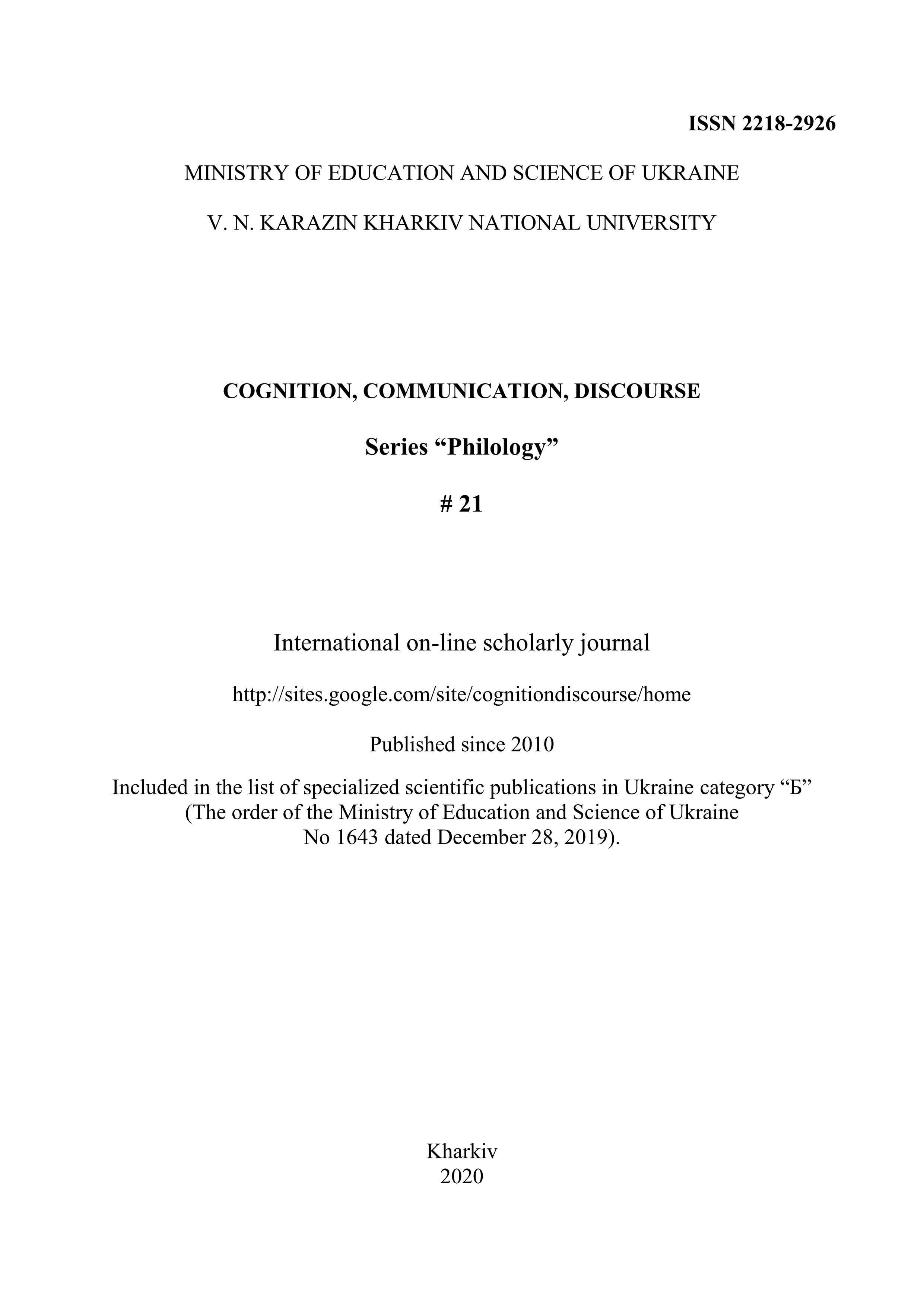The process of diversification of the non-verbal communicative components in the modern English discourse
Abstract
This article focuses on the specific properties of the combinability of non-verbal components with each other in the modern English discourse including the characteristics of their interaction with verbal components. The structural, semantic and pragmatic features of non-verbal components as well as their universal, ethnospecific and individually meaningful characteristics are taken into account. The paper is based on the discourse methodology in analysing communicative phenomena. The complex nature of communication is presented as the unity of verbal and non-verbal components within the anthropocentric paradigm in language and speech research. This paper provides the research of the combinability of non-verbal communicative components with each other, the result of which is presented by different clusters of non-verbal components taking into account the characteristics of a discursive personality upon which depend the ways of diversifying the information and emotion through non-verbal components. The analysis of discourse-constitutive potential of kinesic, proxemic and prosodic communicative components contributes to developing the theory of discursive interaction of different code systems aimed at the investigation of communicative signs of different nature in their unity within the frames of different types of discourse.
Downloads
References
Boguslawska-Tafelska, M. (2011). Manipulation in communication. Or: how ecolinguistics returns a communicator’s powers back to him/her. In New pathways in linguistics (pp. 9–24). Olsztyn: Uniwersytet Warminsko-Mazurski w Olsztynie.
Burgoon, J. K., Buller, D. V., & Woodall, W. G. (1996). Nonverbal communication. The unspoken dialogue. New York: McGraw-Hill Companies, Inc.
Burgoon, J. K., Guerrero, L. K., & Floyd, K. (2016). Nonverbal communication. London & New York: Routledge.
Dijk van, T. A. (2009). Society and discourse. A sociocognitive approach. Cambridge: CUP.
Du Bois, J., & Karkkainen, E. (2012). Taking a stance on emotion: affect, sequence, and intersubjectivity in dialogic interaction. Text and Talk, 32(4), 433-451. https://doi.org/10.1515/text-2012-0021
Ekman, P., Friesen, W. V., & Tomkins, S. S. (1971). Facial affect scoring technique: a first validity study. Semiotica, 3, 37–58.
Hall, E. T. (1968). Proxemics. Current Anthropology, 9, 83–108.
Kalyta, A. (2001). Fonetichnі zasobi aktualіzacії smislu anglіjs’kogo emocіjnogo vislovljuvannj [Phonetic means actualising the meaning of an English emotional utterance]. Kyiv: Publishing centre of Kyiv National Linguistic University.
Kalyta, A. (2015). Phonetic studies from the perspective of an energetics approach. In A. Bondaruk, & A. Prazmowska (Eds.), Within language, beyond theories (Volume I): studies in theoretical linguistics (pp. 322–336). Cambridge: Cambridge Scholars Publishing.
Kalyta, A., & Taranenko, L. (2012). Perceptivna j іnstrumental’na ocіnki emocіjno-pragmatichnogo potencіalu vislovlen’ [Auditory and instrumental evaluation of the utterance emotional-and-pragmatic potential]. Naukovij vіsnik Volins’kogo nacіonal'nogo unіversitetu іmenі Lesі Ukraїnki. Serіja: Fіlolohіchnі nauki: Movoznavstvo, 24(249), 186–191.
Knapp, M. L., & Hall, J. (2010). Nonverbal communication in human interaction. (7th ed.) Orlando, FL: Harcourt Brace Jovanovich.
Kreydlin, G.E. (2002). Neverbal’naya semiotica [Non-verbal semiotics]. Moscow: Novoye Literaturnoye Obozreniye.
Mandal, F. B. (2014). Nonverbal communication in humans. Journal of Human Behavior in the Social Environment, 24(4), 417–421.
Mehrabian, A. (1972). Nonverbal communication. Chicago, IL: Aldine/Atherton.
Remland, M. S. (2009). Nonverbal communication in everyday life. Boston, MA: Allyn & Bacon. Seryakova, I. I. (2017). Semiotichniy prostir tilesnosti anglomovnogo khudozhnyogo discursu [The semiotic space of corporality in the English fiction discourse]. Suchasni tendentsii rozvitku mov. Seriya 9, 15, 189–196.
Sonneborn, L. (2012). Nonverbal communication: the art of body language. New York, NY: Rosen Publishing Group, Inc.
Soloshchuk, L. V. (2006). Vzayemodiya verbal’nih i neverbal’nih componentov komunikacii u suchasnomu anglomovnomu discursi [Interaction of verbal and non-verbal components of communication in the modern English discourse]. Kharkiv: Konstanta.
Soloshchuk, L. V. (2014). Semiotica komunikativnoyi vzayemodiyi v anglomovnomu dialogichnomu dyscursi. [The semiotics of communicative interaction in the English dialogic discourse]. Visnyk Kharkiskogo natsional’nogo universitetu imeni V. N. Karazina, 1102(77), 11–18.
Copyright (c) 2020 Soloshchuk Lyudmila

This work is licensed under a Creative Commons Attribution-NonCommercial-NoDerivatives 4.0 International License.
Authors, who publish with this journal, accept the following conditions:
The authors reserve the copyright of their work and transfer to the journal the right of the first publication of this work under the terms of the Creative Commons Attribution License (CC BY), which allows other persons to freely distribute a published work with mandatory reference to the authors of the original work and the first publication of the work in this journal.
Authors have the right to enter into separate additional agreements for the non-exclusive dissemination of the work in the form in which it was published by this journal (for example, to post the work in the electronic institutions' repository or to publish as part of a monograph), provided that the link to the first publication of the work in this journal is given.
The journal policy allows and encourages the authors to place the manuscripts on the Internet (for example, in the institutions' repositories or on personal websites), both before the presentation of this manuscript to the editorial board and during review procedure, as it contributes to the creation of productive scientific discussion and positively affects the efficiency and dynamics of citing the published work (see The Effect of Open Access).




